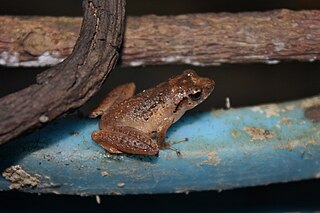
The Rhacophoridae are a family of frogs that occur in tropical sub-Saharan Africa, South India and Sri Lanka, Japan, northeastern India to eastern China and Taiwan, south through the Philippines and Greater Sundas, and Sulawesi. They are commonly known as shrub frogs, or more ambiguously as "moss frogs" or "bush frogs". Some Rhacophoridae are called "tree frogs". Among the most spectacular members of this family are numerous "flying frogs".

The Rhacophorinae are a subfamily of frogs in the family Rhacophoridae. They range from tropical Africa and Asia to temperate China and Japan.

Rhacophorus is a genus of frogs in the shrub frog family (Rhacophoridae) and the related Hylidae make up the true tree frogs. They are found in India, Japan, China, and Southeast Asia. Over 40 species are currently recognised.

Polypedates is a genus of frogs in the family Rhacophoridae, the shrub frogs and Paleotropic tree frogs. They belong to subfamily Rhacophorinae. Members of this genus are collectively known as whipping frogs. They occur in eastern and southern Asia.

Buergeria robusta is a species of frog in the family Rhacophoridae. It is sympatric with Buergeria japonica but is much larger in size.

Chirixalus nongkhorensis, also known as the Nongkhor Asian treefrog, Nongkhor pigmy tree frog, Nong Khor bushfrog, and Nongkhor foam-nest treefrog, is a species of frog in the family Rhacophoridae. It is found in north-eastern India (Assam), Myanmar, Thailand, Cambodia, Laos, Vietnam, and Peninsular Malaysia.
Rohanixalus punctatus is a species of frog in the family Rhacophoridae. It is endemic to Myanmar.

Chiromantis kelleri is a species of frog in the family Rhacophoridae. It is found in eastern and southern Ethiopia, northern Kenya, and Somalia; its range probably extends into South Sudan. The specific name kelleri honours Conrad Keller who collected the type series. Common name Keller's foam-nest frog has been proposed for it.

Chiromantis petersii is a species of frog in the family Rhacophoridae. It is found in Kenya and Tanzania and is broadly distributed in the inland areas of both countries. Chiromantis kelleri was previously considered subspecies of Chiromantis petersii, but is currently recognized as a distinct species. These two species are sympatric in northern Kenya.

The grey foam-nest tree frog, or southern foam-nest tree frog, is a species of frog in the family Rhacophoridae. They are found in southern Africa.

Ghatixalus variabilis is a species of frog in the family Rhacophoridae. It is endemic to the Western Ghats of southern India. It has a number of common names, including green tree frog, though it is terrestrial rather than arboreal in its life style.

A tree frog is any species of frog that spends a major portion of its lifespan in trees, known as an arboreal state. Several lineages of frogs among the Neobatrachia suborder have given rise to treefrogs, although they are not closely related to each other.

Gracixalus is a genus of shrub frogs from south-eastern Asia.

Rhacophorus kio is a species of flying frog in the family Rhacophoridae and is found in the rainforests of southeast Asia, in countries such as China, Laos, Thailand, and Vietnam. Its ability to glide and its adhesive toe pads make it well adapted to its habitat of the rainforest. Before a 2006 study by Annemarie Ohler and Magali Delorme, R. kio and Rhacophorus reinwardtii were thought to be the same species. The common name black-webbed treefrog can refer to either species. Compared to other frog species in the area, R. kio not only creates a foam nest that holds their eggs, but also creates a structure with leaves that will wrap around the eggs. While the conservation status of the species is currently classified as of least concern by the IUCN Red List, R. kio faces habitat loss from deforestation to make space for agriculture and other human influences.

Ghatixalus is a genus of frogs in the family Rhacophoridae, subfamily Rhacophorinae. They are endemic to the Western Ghats of southern India. They are the sister taxon to a larger clade consisting of Chiromantis, Feihyla, Taruga, Polypedates, and Rhacophorus. The name of the genus combines words "Ghats" and "Ixalus". The former refers to the Western Ghats, and the latter to now-abandoned genus name that lives as the suffix in many generic names for rhacophorid frogs.

Romerus is a small genus of rhacophorid frogs that are distributed in southern China. Some species now in Romerus were originally placed in Philautus. It is thought to be the most basal genus in the Rhacophorinae.
Rohanixalus senapatiensis, commonly known as Senapti's tree frog, is a species of frog in the family Rhacophoridae endemic to north-eastern India. It is only known from its type locality around the Mabing river near Kangpokpi in Senapati district, Manipur state.

Feihyla inexpectata is a species of frog in the family Rhacophoridae. This recently (2014) described species is endemic to Malaysian Borneo and known from its type locality in the Maliau Basin Conservation Area, Sandakan Division, Sabah and from Danum Valley, also in Sabah. Common name Bornean opposite-fingered tree frog has been coined for it.

Zhangixalus is a genus of frogs in the subfamily Rhacophorinae, family Rhacophoridae. They are collectively known as Zhang's treefrogs. They occur in the Eastern Himalayas, southern China, Taiwan, Japan, and southeast Asia.
Rohanixalus marginis, the Malaysian bubble-nest frog, Malaccan bubble-nest tree frog, or marginal whipping frog, is a species of frog in the family Rhacophoridae. It is endmic to Malaysia, where it has been found in Perlis State Park. Scientists predict it might also live in Thailand.
















